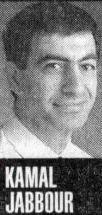

Timing Chip
Pros and Cons
Published June 12, 2000 in The Post-Standard.By Dr Kamal Jabbour, Contributing Writer
On Saturday June 3, 2000, Albany played host to the USATF National 5K Championship at the 22nd Freihofer's Run for Women. Over 3,000 women ran the race. Libbie Hickman of Fort Collins, CO, improved on her third place in 1998 and second place in 1999 to win the national title in a time of 15:35.
Blake Russell of Chapel Hill, NC finished second in 15:43. Sylvia Mosqueda of South Pasadena, CA (15:44), former Liverpool High School runner Jenn Rhines of Haverford, PA (15:51), Laura Baker of Dorchester, MA (16:00), Kate Fonshell of Ardmore, PA (16:02) and Donna Garcia of Marietta, GA (16:08) rounded the top seven.
In masters competition, Carmen Troncoso of Austin, TX won in 16:28, followed by Judi St. Hilaire of Somerset, MA in 16:31, Maria Trujillo de Rios of Los Gatos, CA in 17:09, Jane Welzel of Fort Collins, CO in 17:32, and Patty Ford of Pompey, NY in 17:54.
Besides the windy conditions that followed a thunderous night, talk among the runners focused on the adverse effects of new technology on their times. For the first time in the race's history, organizers introduced the ChampionChip or "chip" timing system to simplify the task of tallying results.
The chip is a small plastic disk shaped like a spaceship, about an inch in diameter, that a runner laces onto her shoe. It is a passive device with no battery. When the runner passes over a special mat, coils inside the chip are energized by electromagnets in the mats, activating a small transponder that emits a unique identifying code. Antennas in the mat receive the code and store it in a nearby computer, which matches it to a runner's name and a time reference.
Unhappy with existing timing systems, a group of runners at the University of Twente in the Netherlands invented the chip in November 1993. The Berlin Marathon became their first international customer in September 1994, and many large races around the world gradually adopted the chip.
Since congestion and a slow start characterize large races, organizers turned to the chip to give runners better results. By placing a mat at the start of the race and a second mat the finish, and subtracting a runner's times between the two mats, the chip promises runners their true racing
Kamal Jabbour runs and writes on the hills of Pompey, New York. His RUNNING Column appears in The Post-Standard on Mondays. He maintains TrackMeets.com, the world leader in live track webcasting, and receives email at jabbour@syr.edu.
